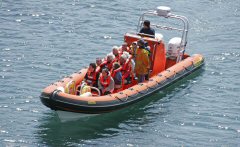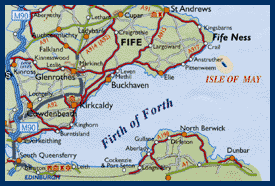Another boat connection

 The Isle of May, situated in the mouth of the Firth of Forth, is only
one and a half kilometres long, yet is a haven for thousands of nesting
sea birds and breeding seals who flourish on the steep sea cliffs
and rocky shores. It has been a National Nature Reserve since 1965.
The Isle of May, situated in the mouth of the Firth of Forth, is only
one and a half kilometres long, yet is a haven for thousands of nesting
sea birds and breeding seals who flourish on the steep sea cliffs
and rocky shores. It has been a National Nature Reserve since 1965.
There are impressive vertical cliffs all along the west coast
teeming with seabirds in early summer. The island is treeless and
rugged, but there are tracks and marked paths which allow you to
visit all parts without difficulty.
In order not to disturb the nesting birds you are expected to
keep to these paths.
 From April to July the sea cliffs are covered with breeding kittiwakes,
razorbills, guillemots and shags. Inland thousands of burrow-nesting
puffins can be seen and eider ducks are abundant.
There are usually breeding terns and you may see grey seals.
Grey seals can be seen all year round, but there are many more in
October when they give birth to their pups.
On the boat trip you will encounter vast numbers of seabirds coming
and going, and even if you are unable to land it is will worth
making the journey to see the spectacular cliff scenery.
From April to July the sea cliffs are covered with breeding kittiwakes,
razorbills, guillemots and shags. Inland thousands of burrow-nesting
puffins can be seen and eider ducks are abundant.
There are usually breeding terns and you may see grey seals.
Grey seals can be seen all year round, but there are many more in
October when they give birth to their pups.
On the boat trip you will encounter vast numbers of seabirds coming
and going, and even if you are unable to land it is will worth
making the journey to see the spectacular cliff scenery.
You can visit the remains of the 12th century monastery, which is currently
being excavated as part of a four year archaeological programme aimed
at interpreting the historic environment of the island.
Remains of human exploitation of the island have been found dating back
over 2000 years, and it is hoped to find evidence of the buildings
occupied by Saint Andrian and his followers when they were murdered
by the Vikings in 875.
There are also a number of wartime installations, but most
buildings are associated with the lighthouses, including one of the
first ever to be built in Scotland.
 Spectacular seabird cities crowd in to breed on the western cliff ledges.
About eight thousand pairs of kittiwakes and twelve thousand pairs of
guillemots can be found, together with nearly two thousand razorbills.
Some birds nest simply ledges, others like kittiwakes use a sort of
glue to stick materials to the rock.
In some places fulmars nest amongst the other birds. They are given
lots of space as they can spit an oily-fishy mixture over anything
which disturbs them.
Spectacular seabird cities crowd in to breed on the western cliff ledges.
About eight thousand pairs of kittiwakes and twelve thousand pairs of
guillemots can be found, together with nearly two thousand razorbills.
Some birds nest simply ledges, others like kittiwakes use a sort of
glue to stick materials to the rock.
In some places fulmars nest amongst the other birds. They are given
lots of space as they can spit an oily-fishy mixture over anything
which disturbs them.
Guillemots, razorbills and puffins are so well designed for swimming, with their small, paddle-like wings, that they can only just fly. Most of the birds feed on sandeels, sprats and herring. The shags make up about one thousand pairs resplendent in their dark green glossy plumage. Watch out for them spreading their wings to dry them out around South Horn.
In spring twenty thousand pairs of puffins will leave the sea to dig out a
burrow as a nest. These burrows are quite shallow and over an arm length
long. Sadly it is easy to squash both burrow and puffin, so please always
keep to the paths. Look out for there affectionate beak rubbing, which can
attract a crowd of puffins, as well as human spectators. Puffins, by the
way, flap their wings at around three hundred times a minute.
 Access to the Isle of May is by passenger boat from Anstruther, The May
Princess, which is licensed to carry 100 passengers; it has a saloon,
snack bar and toilets. I've been on this boat: it was a very trip.
Access to the Isle of May is by passenger boat from Anstruther, The May
Princess, which is licensed to carry 100 passengers; it has a saloon,
snack bar and toilets. I've been on this boat: it was a very trip.
The trip is made once daily. Departure times depend on the tides. Tickets are available at the kiosk at Anstruther Harbour approximately one hour before sailing. Due to weather and sea conditions a trip may be cancelled; the decision to cancel any trip is made at the Harbour 1 hour before each trip. Booking is not always necessary but booking and sailing information is available on the 24 hour information line: 01333 310103.
The entire trip is likely to take between 3 and 5 hours. The crossing itself takes between 45 minutes and 1 hour. On most trips you can land and have 1 to 3 hours on the island, depending on the sea and isle conditions on the day. It is always advisable to take warm waterproof clothing and comfortable shoes for walking. Take refreshments with you; there is only a small information centre and toilet facilities on the island. Dogs are not allowed on the island.
See also the Isle of May ferry website.
Another boat connection

Some time back there is another boat travelling to the Isle of May: the Rib Osprey, a 10-meter long boat with bench seats for 12 passengers (waterproofs supplied if needed) that takes generally less than 25 minutes to reach the island.
Osprey offers two types of trips to the Isle of May:
See the Osprey of Anstruther
website.
(Note that there are no longer boats from Crail that do regular trips.)
 To Seabirds on the Isle of May
part 1 or part 2.
To Seabirds on the Isle of May
part 1 or part 2.
 Jos van Geffen --
Home |
Site Map |
Contact Me
Jos van Geffen --
Home |
Site Map |
Contact Me